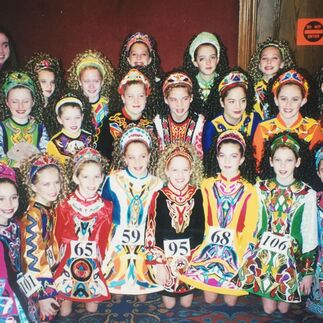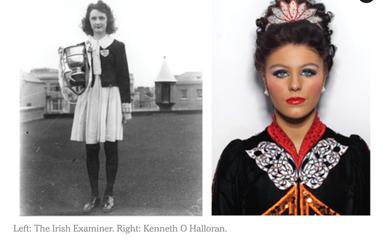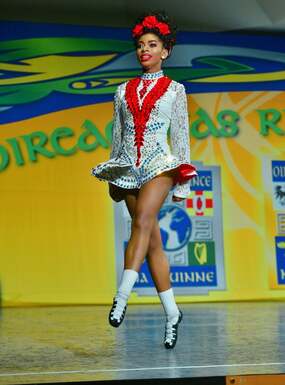 The 1990s were all about going BIG The 1990s were all about going BIG The Look, Part 3: Modern Female Costuming Last week, we were able to make it into the 20th century, but this week we’re breaching the 21st with our discussion of Irish dance female costuming in the modern age! (Catch up on the history here and here.) For our purposes, the modern age of Irish dance is also the competitive age (though the tradition of feiseanna is, of course, a much, much older one!), starting with the establishment of the Irish Dance World Championships in 1970. The formation of this competition forced more rules and regulations into being regarding costuming and gathered together dancers from all over the world in one place—meaning trends were also able to take off. Even in the 1960s, a certain look had been established within Ireland and the trends of bouncy, curled hair (a long-ago Sunday church staple,) brightly colored dresses, and (eventually) deeply tanned legs (in a largely pale-skinned country) spread quickly.  The early 1900s versus the early 2000s The early 1900s versus the early 2000s But it wasn’t until the 90s that the current “look” of Irish dance really took off. Riverdance’s highly theatrical and flashy style not only brought Irish dance to the world’s attention, it also altered the Irish dance world. While Riverdance (the influence of which we’ll discuss more fully in another installment) actually didn’t use traditional Irish dance looks in the show, but rather took a more multi-cultural approach, the showmanship had its effects. Like much in the 90s, dresses got brighter and more sparkly, the wigs got bigger, and theatricality and pageantry became a part of the performance—as the sport grew in popularity, so did dancers’ needs to stand out among the competition. It would be hard to discuss modern, female costuming in Irish dance without bringing up its controversies. The use of fake tan—which is perhaps falling out of favor, but had been a staple of the competitive Irish dance circuit and Irish culture for decades—and makeup, as well as the often extraordinary cost of solo dresses and wigs has come under fire in recent years. Films and documentaries about other forms of dance, such as Cuties (which U.S. Netflix had to remove after an uproar from their audience,) have increased this outcry, while technology’s rapid advancements in the last two decades have left parents fearful their children aren’t given the chance to be children anymore. However, the first thing to note is this: “the look” of an Irish dancer isn’t compulsory, for the most part. Rules are even in place to discourage younger dancers from growing up too quickly--makeup isn’t allowed by the CLRG on dancers 10 or younger. Chances are your female dancer may be getting interested in makeup by 11 on their own—but even then, the heavy makeup used for competitions is part of the costume, necessary for judges to see a dancer’s face clearly under the hot performance lights, and part of all forms of performance for both genders as far back as records go. As far as fake tan goes, there’s no real reason for its prevalence beyond perhaps helping a dancer stand out and maybe look stronger, but natural looks have been have been coming back into fashion (and may go out in favor again—that’s what fads do!)  While still high on glitz, modern Irish dance solo dresses are a little less garish than their predecessors While still high on glitz, modern Irish dance solo dresses are a little less garish than their predecessors The main complaint from parents about many other forms of dance—oversexualization in dance moves—is one Irish dance steers clear away from. Irish dance’s steps may not be exactly what the Druids were doing around their bonfires, but they stem from quite literally ancient traditions and a deeply rooted and hard-won culture. There’s a gravity to Irish dance’s tradition and history that Irish dance’s costuming chooses to celebrate rather than cover up with the bright colors and many rhinestones, the tiara and bejeweled clips for capes and entry numbers (though there is a move to return to Celtic designs, like the more classic Tara brooch.) And while costuming throughout the dance world is also often (perhaps sometimes fairly) criticized, Irish dance’s costumes don’t fall under that category. Though the skirts may be short to better show the dancer’s only moving body parts, they’re generally very heavy fabrics, with long sleeves and often required to cover the collarbones, as well. Their expense is undeniable—though with the advent of computerized embroidery at home (among other innovations) and the continued increase of interest in the sport is helping to drive solo dress prices down—but they still cling to the roots of tradition with Celtic designs and influences. Irish dance, while loved worldwide, is still a somewhat insular community. However, it’s still a community! That means not every dress has to be brand new--the secondhand Irish dance solo dress market is a buzzing one! Last question I know is burning the tip of your tongue: why the wigs? The answer is simple: it’s easier and more restful than sleeping in rollers! Curled hair was synonymous with “dressed up” in Ireland for many years, and the bouncy curls as part of a dancer’s look has a far longer tradition than anything else they're wearing! Eventually, dancers simply got sick of being uncomfortable the night before a big competition, and switched over the wigs instead—which allowed for bigger and bigger hair. While styles have transitioned into lighter, curled buns and shorter, less heavy, curled wigs, it’s again part of the theatrical look and doesn’t seem to be going anywhere anytime soon! Don’t worry, boys, we didn’t forget about you! Tune in next week for the last part of our Irish dance costuming series: all about the evolution of the male dancer’s costumes throughout the ages. This post is part of a series. Take a look at our last “Origins of Irish Dance” post, all about both male and female hard and soft shoes, here. Also: check out the blog every Monday and Thursday for more posts about Irish history, dance culture, community news, and spotlights on our dancers, staff, and families—among other fun projects! And don’t forget to dance along with us on both Facebook and Instagram.
0 Comments
Your comment will be posted after it is approved.
Leave a Reply. |
SRL NewsFind all of our latest news on our Scoil Rince Luimni Facebook page! Categories
All
Archives
August 2022
|
 RSS Feed
RSS Feed